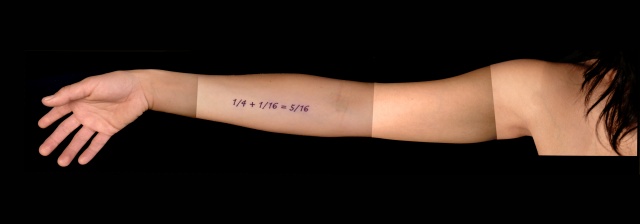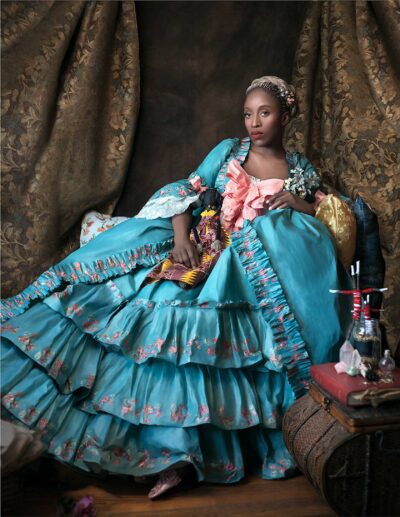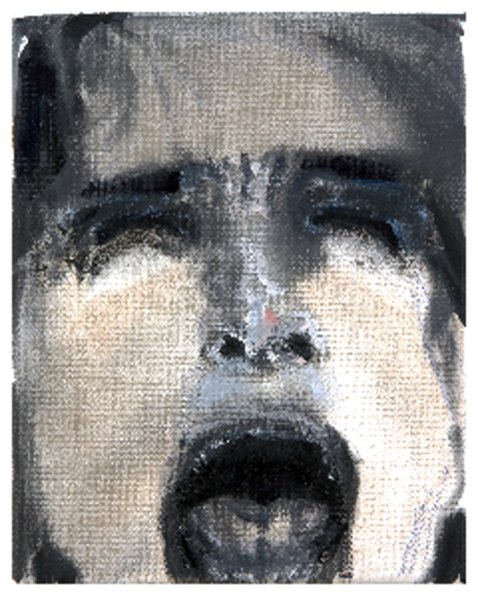Blog 8: Diverse Perspectives Reflected in Post-Modern Art
Today there are more artists than ever before, with a wider range of styles, themes, and platforms. One factor that is significantly different about art now than in the earlier time periods we've looked at is the diversity. For centuries, the art world was ruled primarily by white males. Now there are artists from all different backgrounds. Today we will be taking a look on how diverse perspectives are reflected in modern art.
Our first piece is by Alaska Native artist, Erica Lord, is from her collection called "The Tanning Project." Entitled "I Tan to Look More Native," this piece is a digital photograph of Erica Lord herself. Created in 2006 in the U.S. (exact origin of creation unknown), this piece reflects Erica Lord's thoughts on cultural identity and beauty standards. Erica Lord is from mixed ancestry, including Athabaskan, Inupiaq, Finnish, Swedish, Japanese, and English. She explores how identity and culture are affected by the changing world. This collection includes other pieces, such as "Colonize Me," "Indian Looking," and "Half Breed." They explore the difficulty of having mixed racial backgrounds. This also acknowledges tanning as a beauty standard. Tanning has become increasingly more popular and this piece contrasts the struggles of a history of colonized people with Western vanity.
One aspect of this piece I find particularly powerful is that the artist is the model. Her art is bold and sends a powerful message. The work is personal to her and what she has experienced, along with other Native Americans. Her stance is also noteworthy. It gives the feel of confidence. It shows how she has pride in being Native. Her position shows off femininity. This adds too the beauty standard aspect that is represented. Also, her face is blank, which adds more seriousness. Lastly, the use of space allows the subject to be the sole focus.
The next artwork we're going to look at is a two part collection by Erica Lord. The collection is called Tattooed Arms and was made in 2007 in the U.S.. The first image is entitled Blood Quantum (1/4 +1/16 = 5/16). This piece of art is inspired by the "Blood Quantum" which was a controversial measurement of one's Native American ancestry. In order to be legally considered a Native American, there must be a certain percentage reached. The particular numbers in the artwork are based off of Erica Lord's ancestry. She is 1/4 Athabaskan and 1/16 Inupiaq, totaling 5/16 Native American ancestry. The second piece is called Enrollment Number. The Bureau of Indian Affairs assigns numbers to all Native individuals.
The use of digital editing to make the arms appear spliced together gives it the fractional feel that is also represented by the tattoos. I think this really adds to the artwork and helps express what the artist intended. Another aspect that adds to the piece is that there is no clothing, face, or identifiable marks other than the tattoos. I think this makes the art impersonal, which enhances the idea that to the historically, Native identities are reduced to just numbers and fractions. The last element that I think is important is the use of space. There is only the person and the dark background. It keeps the image simple. The naked body, the relaxed and outspread position of the arms, and empty space almost makes the image feel like it's from an autopsy. Combined, these images critique the Naive American experience in society. They also reflect that the "Blood Quantum" is a form of erasure. Native culture is important to the history of the U.S. and is often overlooked. These powerful art pieces call attention to important pieces of history.
Our next artist is James Luna. James Luna is a Californian artist of Mexican and Native American descent. One of his prominent works, Artifact Piece, was done in 1987 at the San Diego Museum of Man and is considered a performance and installation artwork. The artist lays as a museum display, naked apart from a cloth covering his private region. Different scars and personal belongings are labeled, similar to a real museum exhibit. This piece is the artists resistance to the Western culture and a call-out of Western art and it's exclusion and re-imagination of Native culture. The Native American narrative was overlooked from the beginning, and history and art has been told from the White perspective. James Luna disagrees with items and belongings from cultures that were pushed to/near extinction being put into museums for white people to gawk at. Author Ellen Fernandez-Sacco stated in her book "Blinded by the White: Art and History at the Limits of Whiteness," that "Luna uses his body as an intervention, as physical evidence that he is part of that American experience."
Various elements of this piece elicit emotions such as curiosity, discomfort, and thoughtfulness. The presence of a live human, laying vulnerable and naked on a table is very impactful. The space is also very influential. This exhibit took place in a museum, where things are often old and preserved. A real person is a shocking contrast, and certainly makes a statement. It's very personal, and I think that causes discomfort. Especially with the scars and personal details being labeled and shared with the world. It would make someone curious, why is he doing this? What is his story? This certainly works to his advantage. I think the sound also would have an impact. Apart from museum goers talking and moving, the museum is quiet. This allows the fact that there's a breathing person for display to really sink in. I think this adds to the discomfort, but also would provoke deeper thoughts from viewers.
On a different note, we have "Madame Beauvoir's Painting," by Fabiola Jean-Louis. This work was created in 2016 in New York and combines photography and sculpture. This image depicts an elegantly dressed Black woman painting the historically famous "The Scourged Back." This was a photograph was taken in 1863 of the scars on the back of an enslaved man named Gordon. The gown that is worn by the woman is delicately constructed from paper. This piece is from Jean-Louis's collection "Rewriting History." The goal of these pieces was to draw connections to the past and call attention to the violence against Black people. Her photographs use these paper gowns to rewrite narratives and question power structures. These types of dresses were typically worn by white nobility, and often at the expense of Black lives.
One of the aspects that stands out in this photograph is the fact that it does not appear quite like a photograph. I didn't believe it was a photograph at first, I thought it was a painting. Post production editing smoothed the lines and the skin to make things appear softer and smoother, like a painting. This characteristic can be seen in her other works. This could be used to appear like the portraits from the history Jean-Louis is retelling. Another element that makes this painting stand out is the juxtaposition of the delicacy of the gown and the gruesome horrors the man in the painting endured. This is also used to call out the difference in histories. Nobility lived lavish lives, while others lived through horror and enslavement. This contrast is effective in capturing attention and provoking thoughts. The last element I want to discuss is the texture. As the gown is made of paper, it gives it a crinkly, dynamic texture. The use of paper is symbolic. Jean-Louis uses it to represent the layers of time, delicacy, and transformation.
To add to the previous work, I included a second photograph from the "Rewriting History" collection. This piece is entitled "Marie Antionette is Dead" and may appear quite similar to a famous historic painting. "Marie Antionette is Dead" was also created in 2016 in New York. The painting it mirrors was created in 1759 and is titled "Portrait of Madame de Pompadour." This is a clear example of Jean-Louis's retelling of narratives.
This Jean-Louis painting has similar characteristics to the previous one we looked at. The paper texture of the gown creates a fragile, crinkly texture. This contrasts with the smooth and shiny texture of the drapes. The paper dress also provides volume, which makes it appear more elegant. There is a strong color contrast between the bright blue and pink gown and the surroundings. This makes the woman stand out. One thing I enjoy about this painting is that it's a bit cluttered. There are various items on the side table, the dress details takes up space, and the woman also holds a bundle of flowers and a Black doll. This is similar to the older painting, but I find the older one less enjoyable. One notable difference between the two is the facial expression. The woman in "Portrait of Madame de Pompadour" has a soft expression, with a slight smile. She gazes in a different direction and appears happy. The woman in "Marie Antionette is Dead" has a stern expression and gazes directly into the camera. She looks serious and powerful.
Our last artwork is a painting by Marlene Dumas, created in 2012 and was first exhibited in Milan. This piece is called "Mamma Roma" and is a distressing close up of a woman in an anguished cry. It is based off the actress Anna Magnani crying in pain after the los of her son in the film Mamma Roma. Dumas began depicting mothers pain of child loss in 1994. This painting focuses on the raw emotion that one should never have to experience. A mothers bond with her child is particularly strong. While mother and children have been depicted together in historic paintings, female emotion is typically avoided.
The most obvious aspect of this painting is the deformity of the face in emotion. The woman's eyes a shut tightly, you can see the scrunch of her face in the lines on her brow, and her mouth is wide open. You could imagine the sound coming from her mouth. Regardless where you look at the painting, there is no relief. It is anguish all over. Another element that is powerful is the use of space. We are quite zoomed in on the woman's face. Again, there is no escape from this emotion. Having the painting as close-up as it is adds to the severity of this state and also reflects that the pain of losing a child cannot be escaped. Lastly, the monochrome aspect gives it a moody, yet not overly dramatic feel. It takes the drama away and instead adds emotion. These works were selected due to their diverse artists as well as the diversity and historical significance in their content. From this you can see how art content and art mediums have grown and changed, as well as how the art world is not held by white males.
Sources:
K. Smith. "Curator's Choice: Marie Antionette is Dead." Fowler Museum at UCLA.
https://fowler.ucla.edu/curators-choice-marie-antoinette-is-dead/
E. Caldwell. "How Luiseno Indian Artist James Luna Resists Cultural Appropriation." JSTOP Daily. (2015)
https://daily.jstor.org/native-disruptions-with-artist-james-luna/
C. Daniher. "The Pose as Interventionist Gesture: Erica Lord and Decolonizing the Proper Subject of Memory." Northwestern University.
E. Lord. "Erica Lord". Erica Lord. https://ericalord.com/home.html
N. Kuhl. "Rewriting History by Fabiola Jean-Louis". Beinecke Rare Book & Manuscript Library. (2021)
https://beinecke.library.yale.edu/article/rewriting-history-fabiola-jean-louis
"Mamma Roma". Pinault Collection.
https://lesoeuvres.pinaultcollection.com/en/artwork/mamma-roma








I like the cultural mix that is expressed in the new age of art, pointing out cultural differences and things that happen. Art is a way to bring attention to some of the issues other people are dealing with and this new age allowed them an opportunity to express some of these issues.
ReplyDeleteThe first two pieces displayed are powerful, and cause the viewer to stop and think. However, James Luna's piece does a better job of provoking discomfort and curiosity. I can imagine that this would have been quite the performance art to see, especially with his personal belongings on display beside him. (However, I did have to google the piece since it did not load for me in your blog.) Jean-Louis's works are stunning, and I was surprised to learn that it was a photograph instead of a painting. I love what the paper gowns represent, and the strong contrasts between her work and the historical image she is mirroring. The strong, stern look in "Marie Antionette is Dead" is powerful enough to send shivers down one's spine. Truly a captivating piece with all its elements. "Mamma Roma" is a powerful piece that resonated with me as a woman who has experienced this loss. They did an amazing job of displaying the raw emotion of a mother experiencing the loss of her child.
ReplyDelete